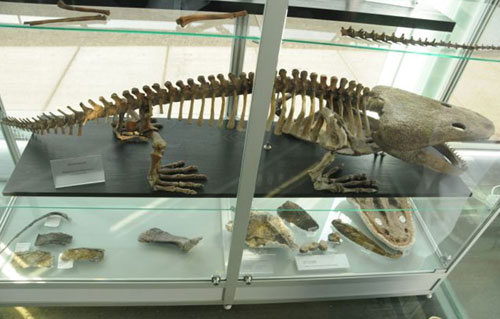Giant dinosaurs dug out of the cave
According to researchers, giant amphibian dinosaurs have once dug underground burrows to hibernate when water sources become scarce.

A fossil skeleton of Metaposaurus diagnosticus
The Metoposaurus diagnosticus weighs half a ton and is over 3m long. Researchers have found that the dry season, which spanned 230 million years ago, caused them to burrow and lie dormant underground to sustain life.
The burrowing behavior of Metoposaurus was discovered by Dorota Konietzko-Meie of Opole University (Poland) and Martin Sander of the University of Bonn (Germany), published in the Journal of Vertebrate Paleontology . From evidence such as Metaposaurus diagnosticus with flat, wide, broad head and large arm bones, the researchers concluded that in the rainy season, the species swam in the lake and when the dry season started, they burrowing underground. The researchers cut the bone layer of this species and found development rings, called annuli . Annuli is similar to wood grain, a bright ring and a dark ring showing a year of growth.
In other amphibian species, annuli usually consist of a wide range showing rapid growth in the rainy season and immediately adjacent to a narrow range to indicate slow growth in the dry season. But for Metoposaurus, after a long period of slow growth is a pause in the dry season.
Daily Mail page quoted Professor Konietzo-Meier: 'The long bones of species of Metoposaurus are very special. According to our interpretation it corresponds to a two-season climate, with a shorter, more favorable rainy season and a prolonged dry section when life conditions become more severe. '
- 70 million years old dinosaurs
- Scary people into the giant cave, the hiding place of the pythons in Son La
- The truth about the mysterious red-haired giant at Lovelock Cave
- Discover new giant dinosaurs
- Discover new giant dinosaurs in Russia
- Why do giant dinosaurs give birth to babies?
- Giant size of dinosaurs
- Dinosaurs are much lighter than previously assumed
- 6 things you read about dinosaurs when you were young, but are no longer true
- Discovered a new giant dinosaur twice the size of an elephant
- 10 weird, hard to imagine dinosaurs
- Dinosaurs evolved into today's birds
 Discovered an ancient centipede fossil 99 million years old
Discovered an ancient centipede fossil 99 million years old Discovered bat-like dinosaurs in China
Discovered bat-like dinosaurs in China Discovered a 200-year-old bronze cannon of the coast
Discovered a 200-year-old bronze cannon of the coast Discover 305 million-year-old spider fossils
Discover 305 million-year-old spider fossils